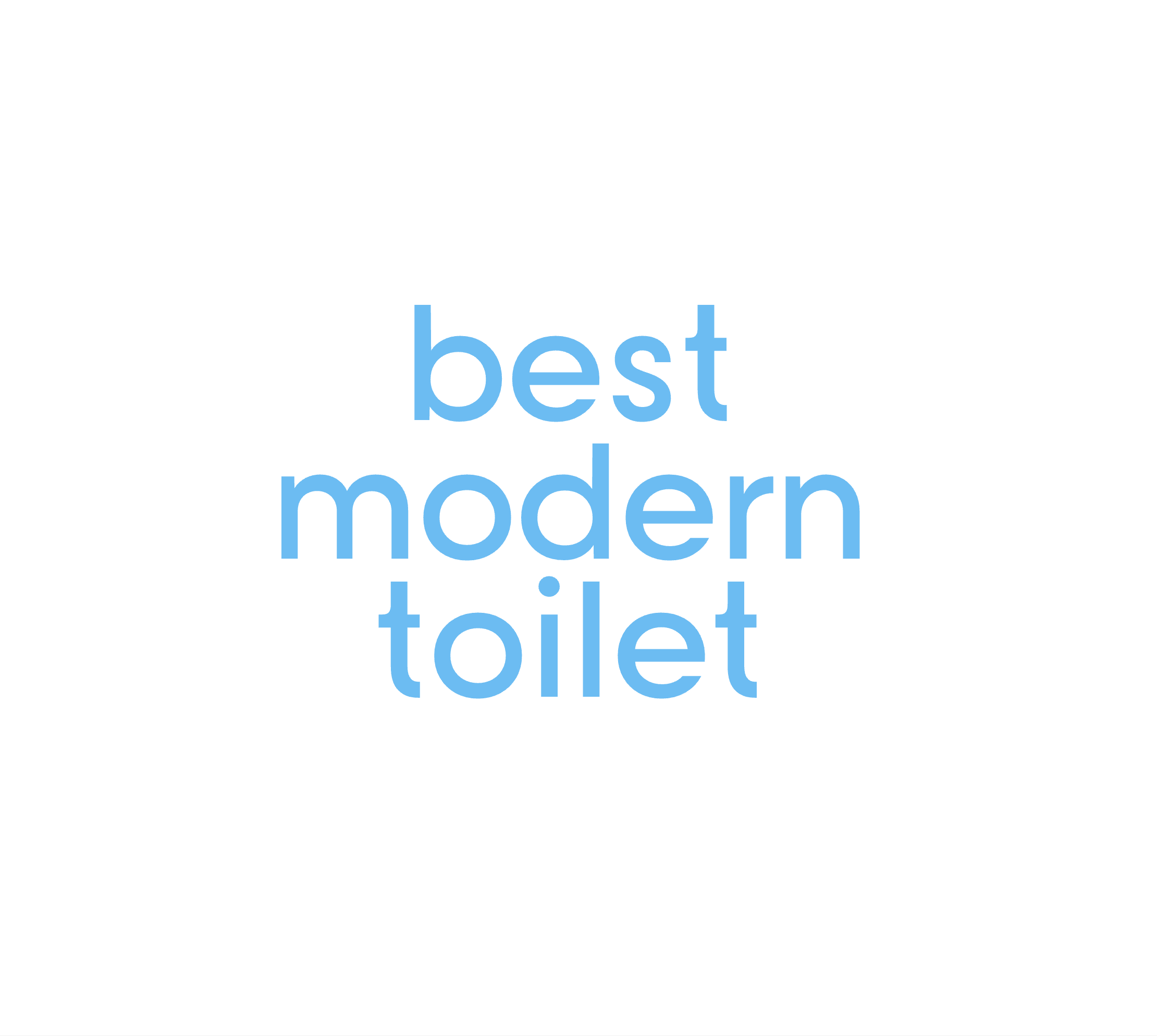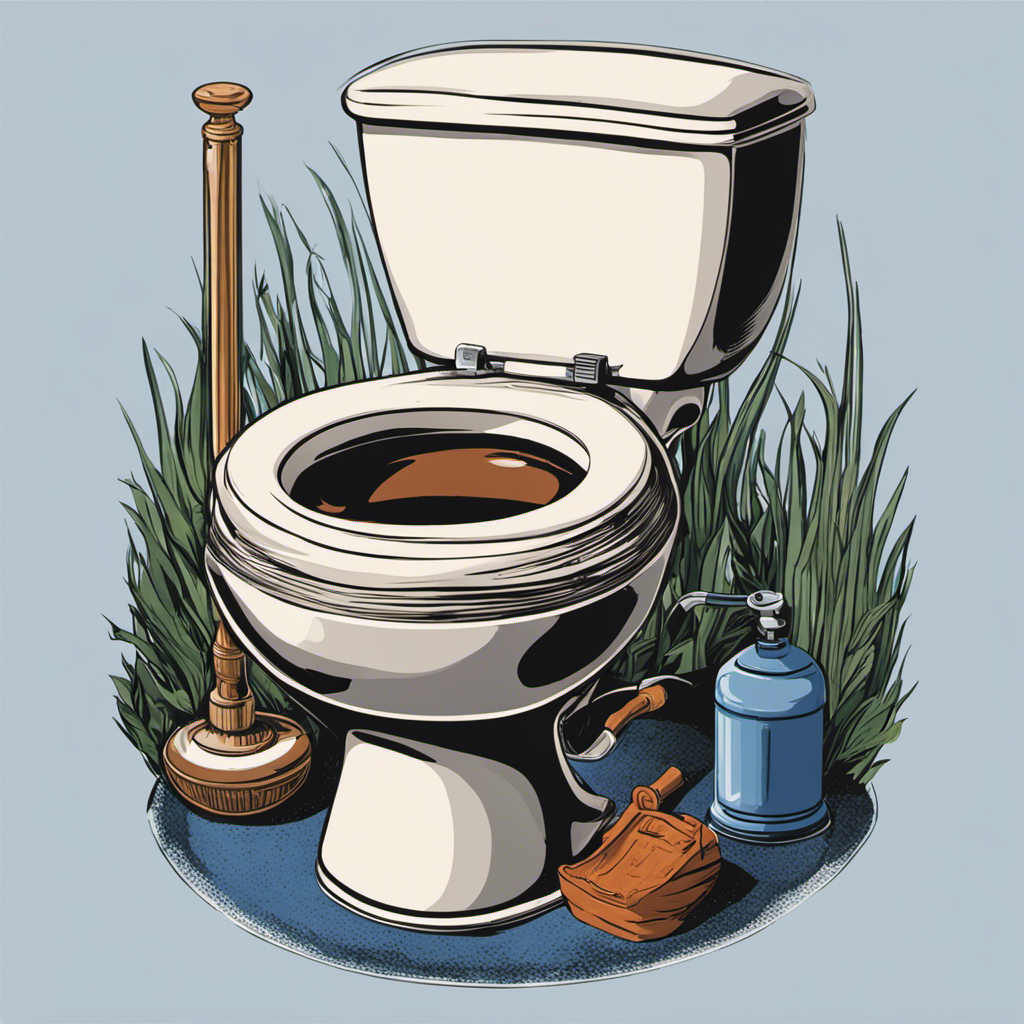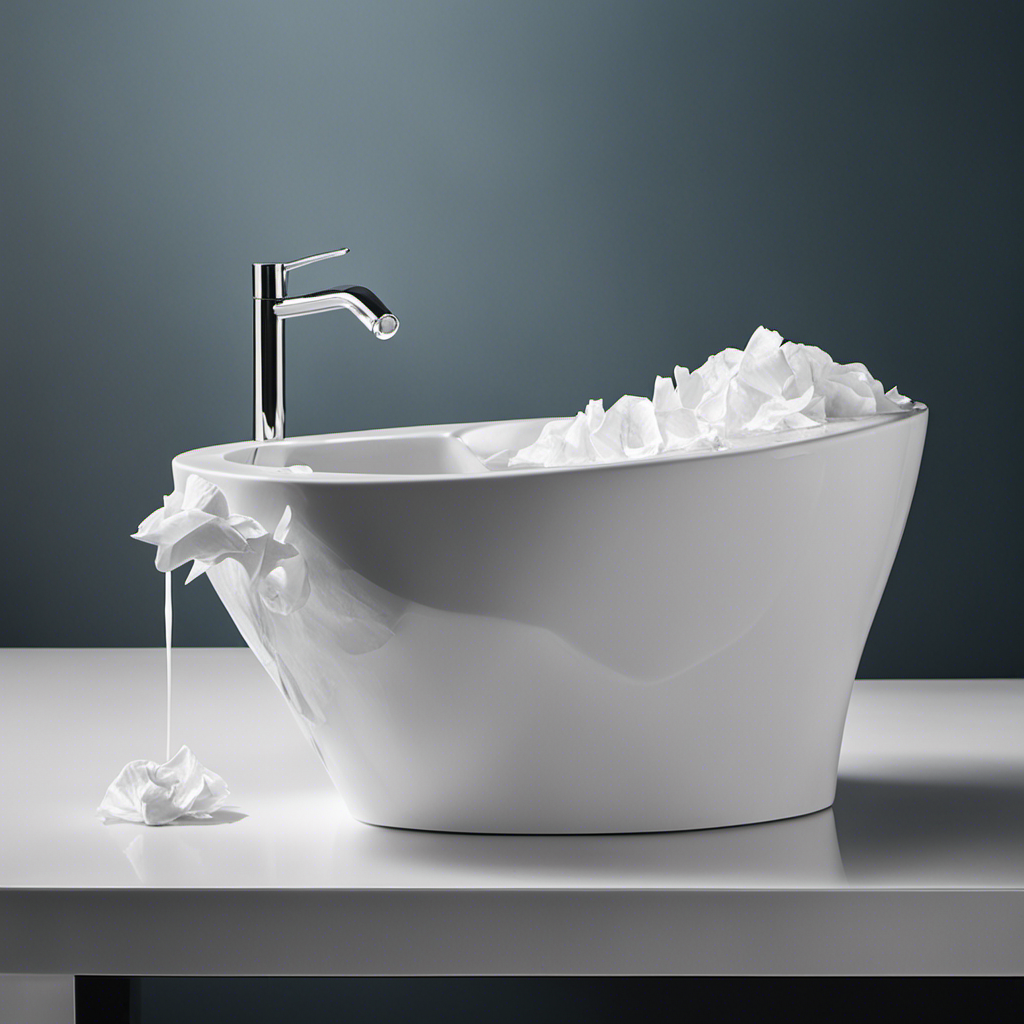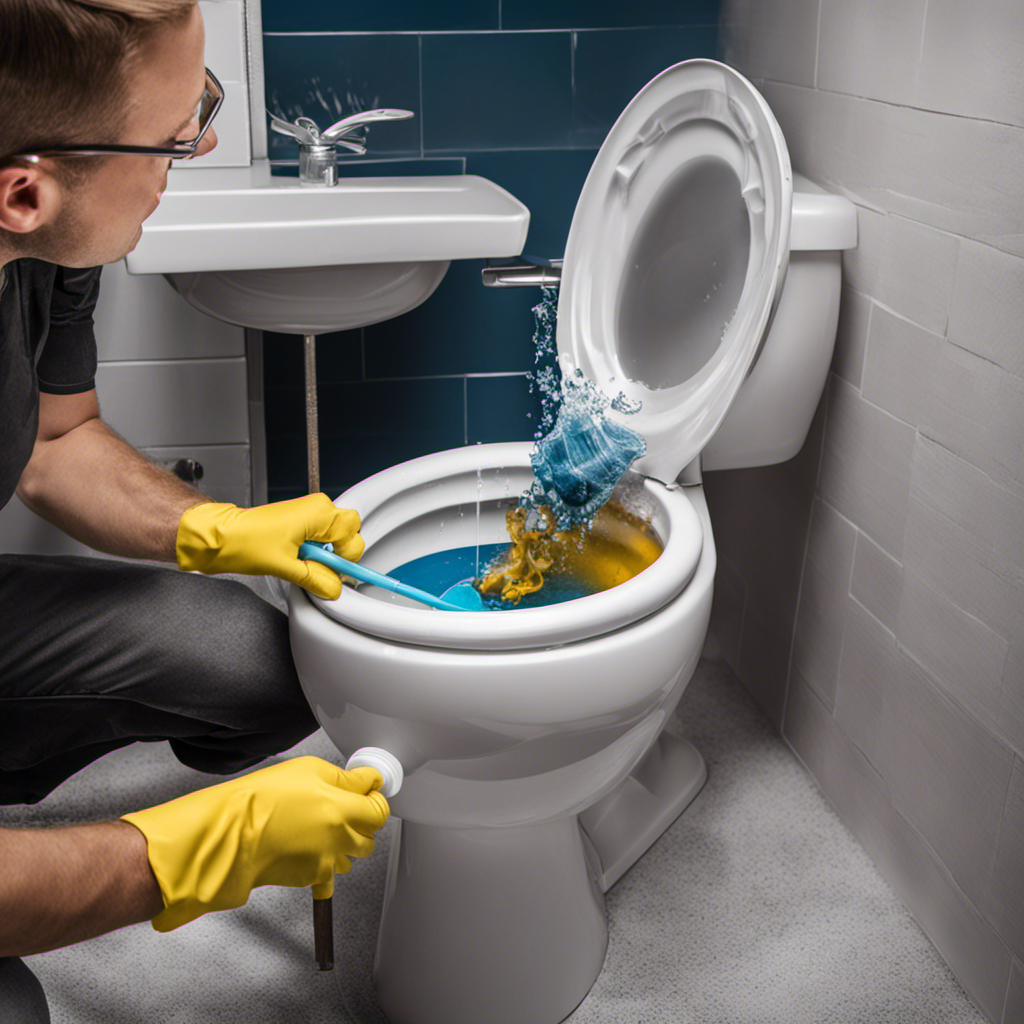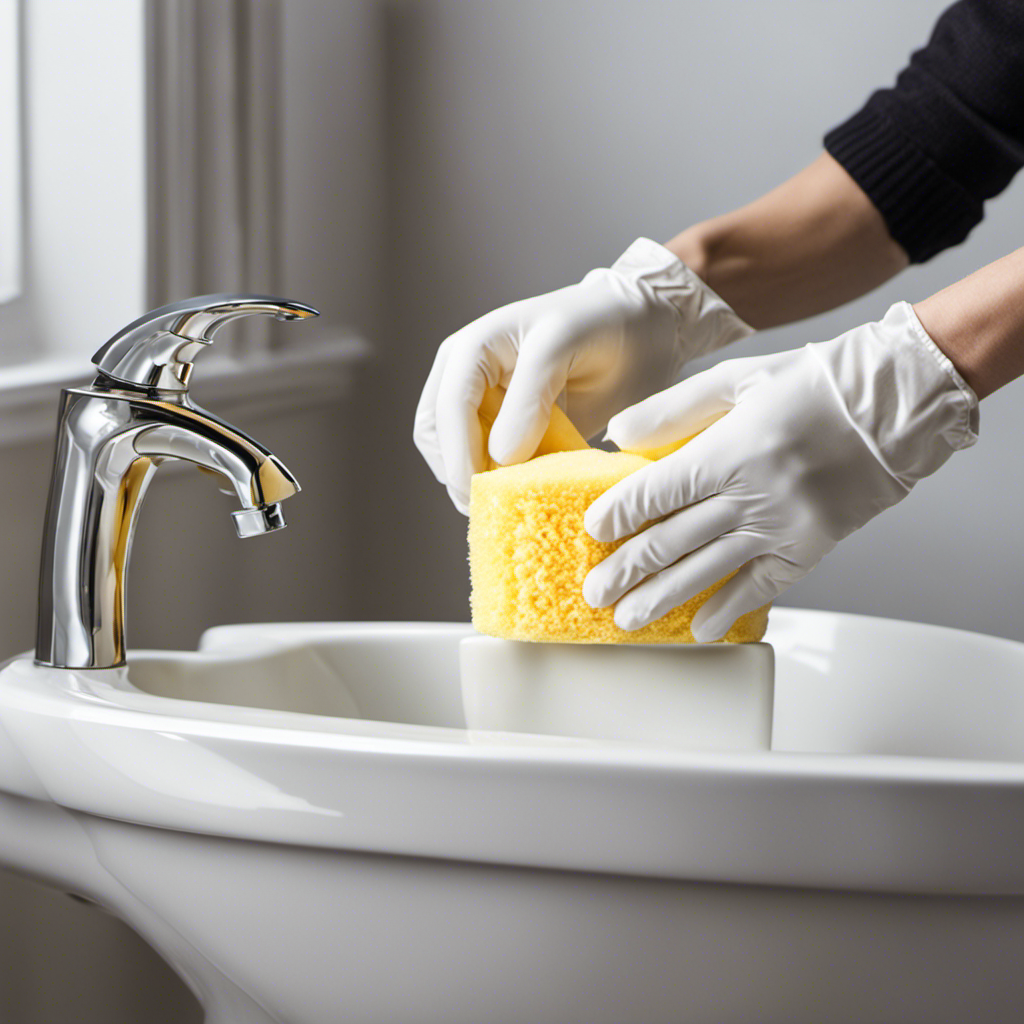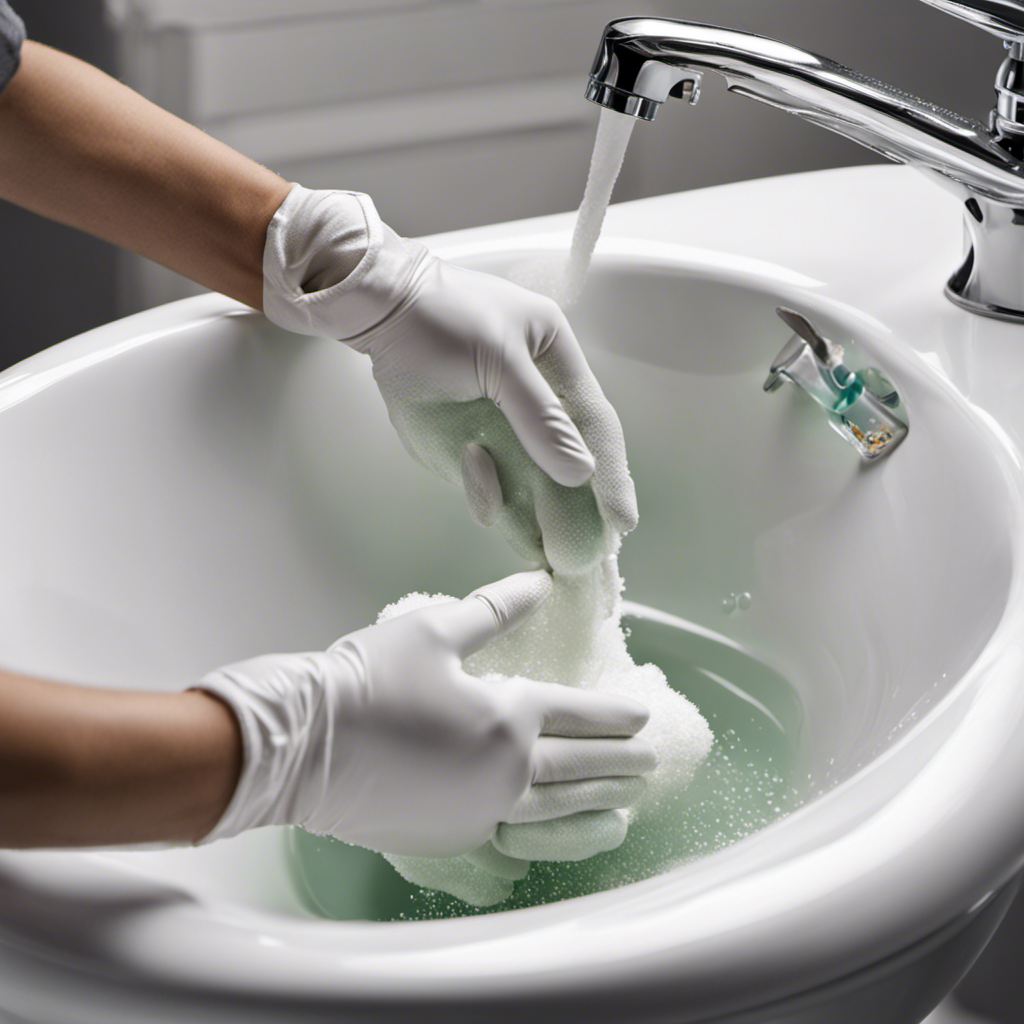Bathtub
How to Remove the Drain From a Bathtub
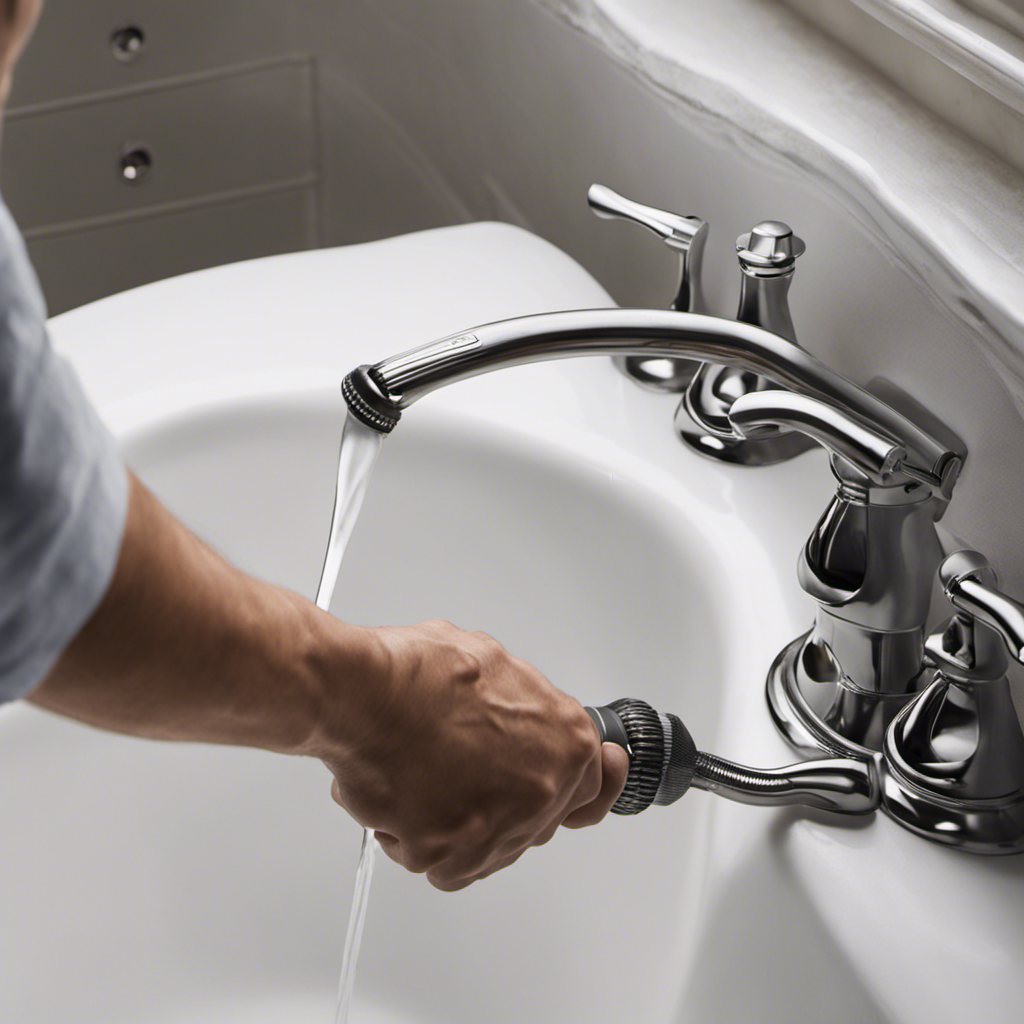
So, you’re tired of dealing with that stubborn bathtub drain, huh? Well, fear not, my friend, because I’ve got just the solution for you.
In this step-by-step guide, I’m going to show you exactly how to remove the drain from your bathtub. With a few simple tools and a little bit of elbow grease, you’ll have that drain out in no time. Trust me, it’s easier than you think.
Let’s get started, shall we?
Key Takeaways
- Gather all necessary tools and prepare the area around the bathtub before starting the process.
- Remove the overflow plate by unscrewing the screws and gently pulling it away from the bathtub.
- Detach the drain stopper by inspecting it for damage, loosening the screw or lever, and lifting the lever to release the stopper from the drain.
- Unscrew the drain flange using a drain key or pliers, and then remove the drain body by loosening it with a wrench or pliers.
Tools Needed for Removing the Drain
To remove the drain from your bathtub, you’ll need a pair of pliers and a screwdriver. These are essential tools for effectively removing the drain without causing any damage.
Here are the step-by-step instructions for drain removal techniques.
-
Start by locating the drain cover. It is usually located in the center of the bathtub.
-
Use the screwdriver to remove the screws securing the drain cover in place.
-
Once the screws are removed, carefully lift the cover off the drain.
-
Next, use the pliers to grip the crossbars of the drain and turn it counterclockwise.
-
Apply steady pressure while turning until the drain is completely unscrewed from the bathtub.
-
Troubleshooting drain removal: If the drain is stuck, try using a lubricant such as WD-40 to loosen it before attempting to unscrew it again.
-
Once the drain is removed, inspect it for any damage or clogs that may need to be addressed.
Preparing the Bathtub for Drain Removal
First, make sure you have gathered all the necessary tools for preparing the bathtub for drain removal. To properly maintain your bathtub and prevent clogs, follow these steps:
-
Clear the area: Remove any items around the bathtub that may obstruct your access to the drain.
-
Protect the surrounding surfaces: Place a towel or old cloth over the bathtub to prevent any scratches or damage during the removal process.
-
Turn off the water supply: Locate the water shut-off valves and turn them off to avoid any accidental water flow while you work.
-
Empty the bathtub: Ensure that the tub is completely drained before proceeding with the removal to prevent any spills or leaks.
Removing the Overflow Plate
After gathering all the necessary tools, I can start removing the overflow plate from the bathtub.
To begin, I locate the screws holding the plate in place. Using a screwdriver, I carefully unscrew them and set them aside. If the screws are rusted or stuck, I can try using a lubricant to loosen them.
Once the screws are removed, I gently pull the overflow plate away from the bathtub. If it doesn’t come off easily, I can use a putty knife or a flathead screwdriver to carefully pry it off.
After removing the plate, I can troubleshoot any common issues such as a clogged or malfunctioning bathtub drain. If necessary, I can then move on to installing a new overflow plate, following the manufacturer’s instructions.
Detaching the Drain Stopper
Once you have located the drain stopper, carefully unscrew it using a screwdriver.
Here’s how to detach the drain stopper:
-
Inspect the stopper for any visible damage or signs of wear. If it’s worn out or broken, you may need to replace it.
-
Look for a small screw or lever on the stopper assembly. This is typically used to hold the stopper in place.
-
If there’s a screw, use a screwdriver to loosen and remove it. If there’s a lever, gently lift it to release the stopper from the drain.
-
Once the stopper is detached, examine the drain for any debris or clogs that may be causing trouble. Clean it thoroughly before proceeding.
With the drain stopper removed, you can now move on to unscrewing the drain flange and continuing the removal process.
Unscrewing the Drain Flange
When it comes to unscrewing the drain flange, it’s important to have the proper tool at hand. Using a drain key or a pair of adjustable pliers with a gripping surface will provide the necessary leverage to loosen the flange.
However, it’s worth noting that potential difficulties may arise, such as rust or corrosion, which can make the unscrewing process more challenging. Therefore, it’s crucial to approach the task with a gentle touch to avoid damaging the drain or surrounding plumbing components.
Proper Tool for Unscrewing
To remove the drain from a bathtub, you’ll need the right tool for unscrewing it. The proper tool for removing screws from a bathtub drain is a drain key or drain wrench. Here’s a step-by-step guide on how to use it:
-
Locate the screws: Look for two or more screws on the drain flange, which is the part that covers the drain hole in the bathtub.
-
Insert the drain key: Place the drain key over the screws and insert it into the drain flange. Make sure it fits securely.
-
Turn counterclockwise: Using a wrench or pliers, turn the drain key counterclockwise to unscrew the drain flange. Apply steady pressure until the flange starts to loosen.
-
Remove the drain flange: Continue turning the drain key until the flange is completely unscrewed. Lift it out of the drain hole to remove it.
Potential Difficulties Encountered
If you encounter any difficulties, you may need to apply more pressure while turning the drain key counterclockwise. Removing a drain from a bathtub can sometimes be challenging, but with the right troubleshooting tips, you can overcome any obstacles that come your way.
Here are some potential difficulties you may encounter and how to address them:
-
Stuck or rusted drain: If the drain is stuck or rusted, try using a penetrating oil to loosen it. Apply the oil and let it sit for a few minutes before attempting to unscrew it again.
-
Stripped drain key: If the drain key gets stripped or worn, try using pliers or a pair of adjustable wrenches to grip the key and turn it counterclockwise.
-
Blocked drain: If the drain is clogged with debris, use a plumber’s snake or a drain auger to remove the blockage before attempting to unscrew the drain.
Importance of Gentle Handling
Gentle handling is crucial when trying to overcome potential difficulties encountered during the removal process. To ensure a successful removal and avoid damage, it is important to follow these gentle handling techniques:
-
Use protective gloves: Before starting the removal process, put on a pair of protective gloves to avoid any injuries and provide a better grip on the drain components.
-
Apply lubrication: Apply a generous amount of lubrication to the drain components. This will help loosen any stuck parts and make the removal process easier.
-
Use gentle force: Avoid using excessive force or sudden jerks when trying to remove the drain. Instead, apply gentle, steady pressure to gradually loosen the components.
-
Be patient and persistent: Removing a drain may require some patience and persistence. If the components are stubborn, try using gentle tapping or wiggling motions to loosen them.
Removing the Drain Body
To remove the drain body, start by locating the screw at the bottom of the drain assembly and use a screwdriver to unscrew it counterclockwise.
Once the screw is removed, the drain body can be detached by twisting it counterclockwise until it comes loose.
Make sure to hold onto the drain body as you unscrew it to prevent it from falling into the drain.
Unscrewing the Drain Body
Start by carefully unscrewing the drain body using a wrench or pliers. Here’s a step-by-step guide to help you with the process:
-
Locate the drain body underneath the bathtub. It is usually located in the center or towards one end of the tub.
-
Use a wrench or pliers to grip the drain body securely. Make sure to choose a tool that fits the drain body properly to avoid slipping and causing damage.
-
Turn the wrench or pliers counterclockwise to loosen the drain body. Apply steady pressure while turning to break any sealant or debris that may be holding it in place.
-
Once the drain body is loose, continue unscrewing it until it is completely removed from the bathtub.
If you encounter any difficulties during this process, such as a stubborn drain body that won’t budge, there are alternative methods you can try.
These include using penetrating oil to loosen any rust or corrosion, applying heat to expand the metal and make it easier to unscrew, or using a drain removal tool specifically designed for this task.
Detaching the Drain Assembly
Using a wrench or pliers, carefully unscrew the drain assembly from the bathtub. This step is crucial in removing the drain completely. However, there are often difficulties encountered during this process. The drain assembly may be stuck due to years of buildup or corrosion. In such cases, applying a penetrating oil can help loosen it. Once the drain assembly is loosened, gently handle it to avoid any damage.
To assist you further, here is a table outlining the step-by-step process of detaching the drain assembly:
| Step | Description |
|---|---|
| 1 | Locate the drain assembly under the bathtub. |
| 2 | Use a wrench or pliers to loosen the drain assembly by turning it counterclockwise. |
| 3 | Apply penetrating oil if the assembly is stuck. |
| 4 | Once loosened, carefully lift the drain assembly out of the bathtub. |
Cleaning and Reinstalling the Drain Components
After removing the drain from the bathtub, it’s important to clean and reinstall the drain components. Here are the steps to follow:
-
Clean the drain components: Use a mild cleaning product and a soft brush to scrub away any dirt, grime, or residue from the drain cover, stopper, and strainer. Rinse them thoroughly with water to remove any leftover cleaning solution.
-
Inspect for damage: Check the drain components for any signs of damage, such as cracks or loose parts. If you notice any issues, it may be necessary to replace the damaged parts before reinstalling.
-
Apply plumber’s putty: Roll a small amount of plumber’s putty into a thin rope and apply it around the bottom edge of the drain flange. This will create a watertight seal when the drain is reinstalled.
-
Reinstall the drain components: Carefully place the drain cover, stopper, and strainer back into their respective positions. Use a wrench to tighten the drain flange securely.
Remember to always follow safety precautions when working with cleaning products and tools. Wear gloves to protect your hands and ensure proper ventilation in the bathroom.
Conclusion
So there you have it! Removing the drain from a bathtub may seem like a daunting task, but with the right tools and step-by-step instructions, it can be easily accomplished.
By following the outlined steps, you can successfully remove the drain and clean or replace any components as needed. Remember to take your time and be cautious throughout the process to avoid any damage.
Now you can confidently tackle this DIY project and enjoy a smoothly functioning bathtub!
With an impeccable eye for detail and a passion for bathroom-related, Ava leads our editorial team gracefully and precisely.
Under her guidance, Best Modern Toilet has flourished as the go-to resource for modern bathroom enthusiasts. In her free time, you might find Ava exploring antique shops and looking for vintage bathroom fixtures to add to her collection.
Bathtub
Is It Safe to Flush Toilet Paper Down the Toilet

When it comes to disposing of toilet paper correctly, we all want to ensure we are doing it properly. But is it safe to flush toilet paper down the toilet? In this article, we will investigate the potential plumbing hazards and environmental effects linked to flushing toilet paper.
We will also discuss alternatives to flushing and provide guidelines for proper toilet paper usage.
So, let’s dive in and discover the best way to handle this essential bathroom task.
Key Takeaways
- Flushing toilet paper can lead to clogged pipes and blockages.
- Toilet clogs can make toilets inoperable and require plumber assistance.
- Toilet paper production contributes to deforestation and climate change.
- Using bidet options or eco-friendly alternatives can reduce the need for toilet paper.
Plumbing Risks
One of the main plumbing risks associated with flushing toilet paper down the toilet is the potential for clogged pipes. When toilet paper is flushed, it travels through the plumbing system and can accumulate in the pipes over time. This accumulation can lead to blockages, resulting in toilet clogs and potential sewage backup.

Toilet clogs can be a major inconvenience, causing toilets to become inoperable and requiring the assistance of a plumber to resolve the issue. Additionally, if the clog is severe enough, it can cause sewage backup, which poses health risks and can lead to costly repairs.
To prevent these plumbing risks, it’s important to only flush toilet paper down the toilet and avoid disposing of other items that can cause clogs.
Environmental Impact
Our environmental impact is a major concern when it comes to flushing toilet paper down the toilet. Toilet paper production contributes significantly to deforestation, making it an unsustainable practice. To understand the gravity of this issue, let’s take a look at the environmental impact of toilet paper production.
| Environmental Impact | Explanation |
|---|---|
| Deforestation | The production of toilet paper requires vast amounts of wood pulp, leading to the destruction of forests. This results in the loss of crucial habitats for plants and animals, and contributes to climate change. |
| Water Consumption | The manufacturing process of toilet paper consumes large quantities of water, which can strain local water supplies and deplete freshwater resources. |
| Chemical Usage | The bleaching process used to make toilet paper white often involves the use of harmful chemicals such as chlorine, which can contaminate water sources and harm aquatic life. |
It is essential for us to consider these environmental consequences and explore more sustainable alternatives, such as using recycled or bamboo toilet paper, to minimize our impact on the planet.

Alternatives to Flushing
Let’s explore alternative options for disposing of toilet paper.
One option to consider is using bidet options. Bidets are fixtures that use water to clean the genital area after using the toilet. They’re commonly found in many countries and are becoming more popular worldwide. Bidet options include standalone bidets, bidet attachments that can be added to existing toilets, or handheld bidet sprayers. By using a bidet, you can reduce or even eliminate the need for toilet paper altogether.
Another alternative is using reusable cloths. These can be made from soft, absorbent materials such as cotton or bamboo. After use, simply wash the cloth with soap and water, and it will be ready for reuse. Reusable cloths are an eco-friendly option that can help reduce waste and minimize the environmental impact of toilet paper disposal.
Proper Toilet Paper Usage
To continue the discussion on proper toilet paper usage, we can now delve into the importance of using toilet paper responsibly and ensuring its proper disposal.

When it comes to toilet paper brands, it’s essential to choose ones that are designed to dissolve easily in water. Look for brands that are labeled as septic-safe or biodegradable. These types of toilet paper are specifically formulated to break down quickly, reducing the risk of clogging your plumbing system or causing damage to your septic tank.
Additionally, regular septic tank maintenance is crucial for preventing issues related to toilet paper usage. Regular pumping and inspection can help identify any potential problems before they escalate.
Proper toilet paper usage, combined with septic tank maintenance, ensures a trouble-free and efficient plumbing system.
In the following section, we’ll provide our conclusion and recommendations regarding toilet paper disposal and alternatives.

Conclusion and Recommendations
To sum up our findings on proper toilet paper usage and disposal, we recommend:
- Selecting septic-safe or biodegradable brands that dissolve easily in water.
- Regularly maintaining your septic tank to prevent potential issues.
Here are our top three recommendations for toilet paper disposal and septic tank maintenance:
- Choose septic-safe or biodegradable brands: Opt for toilet paper that’s specifically designed to break down easily in water. These brands are less likely to cause clogs or damage to your septic system.
- Avoid flushing other materials: Never flush anything other than toilet paper down the toilet. Items like wet wipes, sanitary products, or paper towels can lead to blockages and septic tank problems.
- Regularly maintain your septic tank: Schedule regular inspections and pump-outs to ensure that your septic tank is functioning properly. This will help prevent backups, odors, and costly repairs.
Frequently Asked Questions
Can Flushing Toilet Paper Down the Toilet Cause Clogs in the Plumbing System?
Flushing toilet paper down the toilet can cause clogs in the plumbing system, posing clogging risks. Additionally, it can have negative environmental impacts. It’s essential to dispose of toilet paper properly to avoid these issues.
Is There a Risk of Toilet Paper Causing Damage to the Septic Tank?
There are risks associated with flushing toilet paper down the toilet, including potential damage to the septic tank. Additionally, using alternative toilet paper options can have environmental impacts that should be considered.

Are There Any Health Risks Associated With Flushing Toilet Paper Down the Toilet?
Flushing toilet paper poses no health risks and has numerous health benefits, such as maintaining cleanliness and preventing the spread of germs. However, it is important to consider the environmental impact and use eco-friendly alternatives when possible.
Can Flushing Excessive Amounts of Toilet Paper Lead to Problems With the Municipal Sewage System?
Flushing excessive amounts of toilet paper can potentially lead to problems with the municipal sewage system. It is important to consider the potential environmental impact and explore alternatives to flushing toilet paper, such as using bidets or installing a separate waste bin.
Is It Safe to Flush Toilet Paper With Additives, Such as Scented or Moistened Options, Down the Toilet?
Yes, it is safe to flush regular toilet paper down the toilet. However, when it comes to toilet paper with additives like scents or moisture, there are safety concerns and potential environmental impact to consider.
Conclusion
In conclusion, it’s safe to flush toilet paper down the toilet, as long as it’s used in moderation and not excessive amounts.

However, it’s important to be mindful of the potential plumbing risks and environmental impact.
To minimize these risks, consider using alternatives to flushing, such as bidets or wet wipes, and always follow proper toilet paper usage guidelines.
By taking these precautions, we can maintain a functional plumbing system and contribute to a healthier environment.
With an impeccable eye for detail and a passion for bathroom-related, Ava leads our editorial team gracefully and precisely.
Under her guidance, Best Modern Toilet has flourished as the go-to resource for modern bathroom enthusiasts. In her free time, you might find Ava exploring antique shops and looking for vintage bathroom fixtures to add to her collection.
Bathtub
Can You Flush Toilet Paper in Crete Greece

Have you ever been to Crete, Greece and wondered about the toilet paper disposal situation? We have all the information you need!
In this article, we’ll dive into the plumbing system in Crete and explore the do’s and don’ts of toilet paper disposal. We’ll also discuss the environmental impact of flushing toilet paper and provide some alternative options.
So, grab a seat and get ready to learn all about the best ways to handle your toilet paper experience in Crete. Let’s get started!
Key Takeaways
- The plumbing system in Crete operates efficiently, but specific regulations are in place for toilet paper disposal.
- Flushing toilet paper can cause plumbing issues and may not be suitable for older infrastructure.
- Toilet paper should be placed in a separate bin in Crete, and plastic bags are commonly used to line the bins for easy disposal.
- Flushing toilet paper has significant environmental consequences, including clogged pipes, water pollution, and negative impacts on forests and ecosystems.
Plumbing System in Crete
The plumbing system in Crete, Greece, operates efficiently, allowing us to flush toilet paper without any concerns. In Greece, there are specific plumbing regulations in place that dictate the standards for the country’s plumbing infrastructure. These regulations ensure that the plumbing system can handle the disposal of toilet paper without any issues.

However, it’s important to note that there are cultural differences in toilet paper usage in Greece compared to other countries. While it’s common practice in many places to dispose of toilet paper in the toilet, in Greece it’s often recommended to dispose of it in a separate bin provided in the bathroom. This cultural difference is due to the older infrastructure in some parts of Greece, which may not be able to handle large amounts of toilet paper.
Transitioning into the subsequent section about ‘toilet paper disposal in Crete’, let’s explore the proper methods for disposing of toilet paper in this region.
Toilet Paper Disposal in Crete
We can dispose of toilet paper in Crete, Greece, by placing it in a separate bin provided in the bathroom. It’s a common practice in Crete to not flush toilet paper down the toilet due to the plumbing system’s sensitivity. Instead, you’ll find small bins specifically designated for toilet paper disposal in most bathrooms. These bins are usually lined with plastic bags for easy disposal.
It’s important to adhere to this local custom to avoid any plumbing issues. While it may seem unusual for some visitors, it’s a necessary step to ensure the proper functioning of the plumbing system. By disposing of toilet paper in these bins, we can minimize the risk of clogs and maintain the overall cleanliness and hygiene of the bathroom facilities.

Now that we know how to dispose of toilet paper correctly, let’s delve into the environmental impact of flushing toilet paper.
Environmental Impact of Flushing Toilet Paper
As we consider the environmental impact of flushing toilet paper in Crete, Greece, it’s important to recognize the significant amount of waste that can accumulate in the plumbing system. Flushing toilet paper can have a detrimental impact on sewage systems, as the paper can clog pipes and cause blockages. This not only leads to costly repairs, but also contributes to the pollution of our waterways.
Additionally, the sustainability of toilet paper production is a concern. The production of toilet paper requires the cutting down of trees and the use of chemicals, which can have a negative impact on our forests and ecosystems.
Considering these environmental consequences, it’s crucial to explore alternatives to flushing toilet paper in Crete.

Alternatives to Flushing Toilet Paper in Crete
Toilet paper alternatives in Crete include bidets, which can be a more sustainable option for personal hygiene. In addition to bidets, there are several other cultural practices and alternatives to flushing toilet paper in Crete that you may find interesting:
- Water containers: Many households in Crete have water containers next to the toilet. After using the toilet, instead of using toilet paper, you can pour water from the container to clean yourself.
- Handheld bidet sprayers: These devices are similar to a shower head attached to a hose. With a simple press of a button, you can direct a stream of water for cleaning purposes.
- Wet wipes: While not as sustainable as the previous options, wet wipes are commonly used as an alternative to toilet paper in Crete. However, it’s important to dispose of them properly to prevent clogging the plumbing system.
Tips for a Smooth Toilet Paper Experience in Crete
To ensure a smooth toilet paper experience in Crete, it’s advisable to stock up on an ample supply of toilet paper before your trip. While there are toilet paper brands available in Crete, it’s always better to be prepared, especially if you have specific preferences.
Some popular toilet paper brands in Crete include Papernet, Softline, and Katrin. These brands offer a range of options, from standard to extra soft, ensuring comfort during your bathroom visits.
Additionally, it’s important to adhere to proper public restroom etiquette in Crete. Always remember to flush the toilet paper in the provided bins, as the plumbing systems in Crete may not be able to handle flushing it down the toilet.

Frequently Asked Questions
What Is the Average Cost of Plumbing Services in Crete?
The average cost of plumbing services in Crete can vary depending on the specific needs of the project. It is best to contact local plumbing companies for accurate pricing information.
Can I Flush Wet Wipes Down the Toilet in Crete?
Yes, we can flush wet wipes down the toilet in Crete, Greece. However, it is important to note that only flushable wipes should be used. Alternatively, there are other toilet paper options available.
Are Bidets Commonly Found in Crete Homes?
Bidets, a common fixture in European bathrooms, offer a different approach to personal hygiene. In some countries, like Crete, they are commonly found in homes. Cultural differences in bathroom habits make bidets a popular choice.
Is It Safe to Flush Feminine Hygiene Products in Crete?
Yes, it is safe to flush feminine hygiene products in Crete. However, it is important to consider the disposal methods and the environmental impact of flushing these products.

Are There Any Specific Regulations or Restrictions on Toilet Paper Usage in Crete?
In Crete, Greece, there are no specific regulations or restrictions on toilet paper usage. However, it’s worth considering toilet paper alternatives like bidets or wet wipes to minimize the environmental impact of toilet paper usage.
Conclusion
In conclusion, when visiting Crete, it’s important to remember that the plumbing system may not be able to handle flushing toilet paper. Instead, it’s recommended to dispose of it in the provided waste bin.
This practice not only prevents clogs and damage to the plumbing, but also helps protect the beautiful environment of Crete.
So, let’s take the plunge and adapt to this unique aspect of Crete’s toilet etiquette, ensuring a smooth and sustainable experience for all.

With an impeccable eye for detail and a passion for bathroom-related, Ava leads our editorial team gracefully and precisely.
Under her guidance, Best Modern Toilet has flourished as the go-to resource for modern bathroom enthusiasts. In her free time, you might find Ava exploring antique shops and looking for vintage bathroom fixtures to add to her collection.
Bathtub
Can You Flush a Toilet Without the Lid on

Oh, it’s incredible how we often overlook the little things! It’s astonishing to think about the significant impact that something as basic as flushing a toilet can have on our health and the environment.
In this article, we delve into the importance of flushing with the lid on. We’ll explore the potential health risks of flushing without the lid, how it protects your bathroom, and the environmental consequences.
So, buckle up and get ready to master the art of proper toilet etiquette.
Key Takeaways
- Flushing with the lid on prevents the release of bacteria and viruses into the air.
- Flushing without the lid increases the risk of airborne transmission of pathogens.
- Closing the lid before flushing helps maintain a fresh and clean environment.
- Flushing without the lid can lead to increased water wastage and higher utility bills.
The Importance of Flushing With the Lid on
To maximize hygiene and minimize the spread of germs, it’s essential to always flush the toilet with the lid on.

There are several advantages to this practice. First and foremost, closing the lid prevents the release of a plume of bacteria and viruses into the air. When the toilet is flushed without the lid, these microorganisms can reach surfaces in the bathroom, increasing the risk of contamination.
Additionally, keeping the lid closed helps contain odors, maintaining a more pleasant environment.
However, there are also a few disadvantages to consider. Closing the lid requires an extra step and may inconvenience some individuals. Furthermore, if the lid isn’t properly cleaned, it can become a breeding ground for bacteria.
Therefore, while there are some drawbacks, the advantages of flushing with the lid on far outweigh them in terms of hygiene and preventing the spread of germs.

Potential Health Risks of Flushing Without the Lid
Flushing the toilet without the lid poses potential health risks. Here are four reasons why:
- Potential Contamination: When you flush without the lid, tiny water droplets containing bacteria and other microorganisms can be propelled into the air. These droplets can then settle on surfaces in your bathroom, potentially leading to contamination.
- Spread of Bacteria: Flushing without the lid allows bacteria to spread throughout your bathroom. Bacteria from fecal matter can become airborne and settle on items such as toothbrushes, towels, or even your hands, increasing the risk of illness.
- Increased Aerosolization: The force of the flush can cause a higher level of aerosolization, resulting in a greater dispersion of potentially harmful particles. This can be especially concerning if someone in your household is already sick.
- Potential for Airborne Transmission: Certain bacteria and viruses can survive in the air for extended periods. Flushing without the lid increases the chances of these pathogens becoming airborne, leading to potential respiratory infections.
How Flushing With the Lid on Protects Your Bathroom
By keeping the lid on when we flush, we can effectively protect our bathroom from potential contamination and the spread of bacteria.
The benefits of using a toilet lid are numerous. Firstly, it prevents the release of harmful bacteria and viruses into the air. When we flush without the lid, microscopic particles containing fecal matter and urine are dispersed, settling on surfaces and increasing the risk of contamination.
Secondly, the lid creates a barrier that prevents odors from escaping, maintaining a fresh and clean bathroom environment.

Additionally, using the toilet lid reduces the amount of water that splashes out during flushing, minimizing the need for frequent cleaning.
Alternatives to flushing without the lid include closing the lid before flushing or using a bidet, which eliminates the need for flushing altogether.
Environmental Impact of Flushing Without the Lid
Using the toilet without the lid can have negative environmental impacts, especially in terms of water wastage and energy consumption. Here are four reasons why flushing without the lid can be detrimental to the environment:
- Water Conservation: When the lid is left off, water can easily evaporate, leading to unnecessary water loss. This not only wastes a precious resource but also increases the demand on water treatment facilities.
- Sanitation Standards: Flushing without the lid can result in the spread of harmful bacteria and pathogens. The lid acts as a barrier, preventing these microorganisms from escaping into the air and potentially contaminating surfaces in the bathroom.
- Energy Consumption: Without the lid, air can freely circulate in the toilet bowl, causing the water to evaporate more quickly. As a result, the toilet tank needs to refill more frequently, increasing energy usage and contributing to higher utility bills.
- Odor Control: The lid plays a crucial role in containing unpleasant odors. By leaving it off, foul smells can permeate the bathroom, leading to discomfort and the need for additional air fresheners, which can have their own environmental impact.
Tips for Proper Toilet Etiquette
To ensure proper toilet etiquette, we should always remember to close the lid before leaving the bathroom. This simple act not only keeps the bathroom clean and tidy, but also prevents the spread of germs and bacteria. Etiquette reminders can help maintain a hygienic environment for everyone.

Firstly, it’s important to flush the toilet after every use to remove waste and eliminate any unpleasant odors. Additionally, it’s courteous to use toilet paper sparingly and to properly dispose of it in the provided receptacle.
Furthermore, washing hands thoroughly with soap and water is essential to maintain good hygiene. Lastly, it’s considerate to replenish toilet paper and hand soap if necessary, ensuring the next person has a pleasant experience.
Following these etiquette reminders promotes bathroom cleanliness and a positive experience for all.
Frequently Asked Questions
Can Flushing a Toilet Without the Lid on Cause Damage to the Plumbing System?
Flushing a toilet without the lid on can potentially cause plumbing damage and pose health risks. It is important to keep the lid on to prevent objects from falling in, reduce odors, and minimize the spread of bacteria and germs.

Is It True That Flushing Without the Lid Can Lead to the Spread of Bacteria and Germs?
Yes, flushing without the lid can lead to the spread of bacteria and germs. To prevent this, it is important to always flush with the lid down and practice proper sanitation methods.
What Are the Potential Health Risks Associated With Flushing Without the Lid?
Potential contamination and bacterial transmission are the main health risks associated with flushing without the lid. Without the lid, droplets containing bacteria and germs can be propelled into the air, increasing the chances of spreading illness.
How Does Flushing With the Lid on Protect the Bathroom From Unpleasant Odors?
Flushing without the lid can lead to unpleasant bathroom odors. The lid acts as a barrier, preventing the release of odorous gases into the air. It’s important to keep the lid on to maintain a fresh and odor-free bathroom environment.
Are There Any Environmental Consequences of Flushing Without the Lid?
There are environmental consequences to flushing without the lid on. It can lead to the release of unpleasant odors, which negatively impact air quality. Additionally, it can result in water wastage, reducing our efforts for water conservation.

Conclusion
In conclusion, it’s crucial to always flush the toilet with the lid on to maintain proper hygiene and protect our health. Flushing without the lid can lead to the spread of harmful bacteria and viruses, posing potential health risks.
Additionally, keeping the lid closed helps prevent any unwanted odors from escaping and maintains a clean and pleasant bathroom environment.
Let’s remember to practice proper toilet etiquette by always flushing with the lid securely in place.
With an impeccable eye for detail and a passion for bathroom-related, Ava leads our editorial team gracefully and precisely.
Under her guidance, Best Modern Toilet has flourished as the go-to resource for modern bathroom enthusiasts. In her free time, you might find Ava exploring antique shops and looking for vintage bathroom fixtures to add to her collection.
-

 Bathroom Enhancements2 months ago
Bathroom Enhancements2 months agoWill Hot Bath Lower Blood Pressure
-

 FAQ - Advanced Bathroom Queries3 months ago
FAQ - Advanced Bathroom Queries3 months agoWhich Countries Use Bidets the Most
-
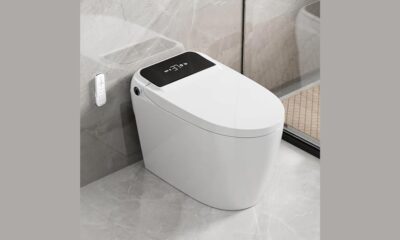
 Reviews1 month ago
Reviews1 month agoLDian Smart Toilet Review [2024]
-
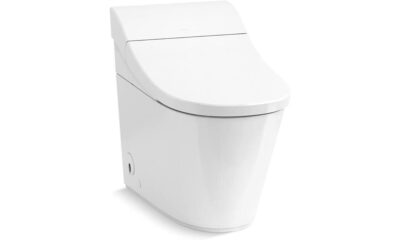
 Reviews2 months ago
Reviews2 months agoKohler Innate Smart Toilet Review [2024]
-
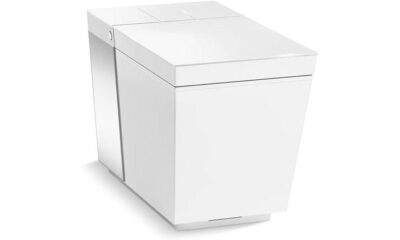
 Reviews2 months ago
Reviews2 months agoKohler NUMI 2.0 Smart Toilet Review [2024]
-
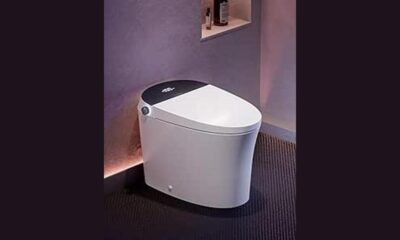
 Reviews2 months ago
Reviews2 months agoCANEST Smart Toilet Review: The Ultimate Bathroom Upgrade [2024]
-

 Toilet Types3 months ago
Toilet Types3 months agoAre Bleach Tablets Bad for Your Toilet
-
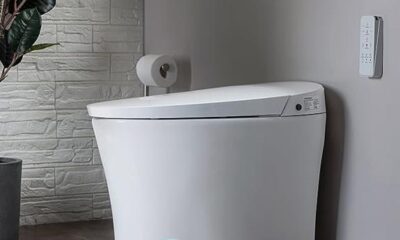
 Reviews2 months ago
Reviews2 months agoWoodbridge B0970S Smart Bidet Toilet Review [2024]
